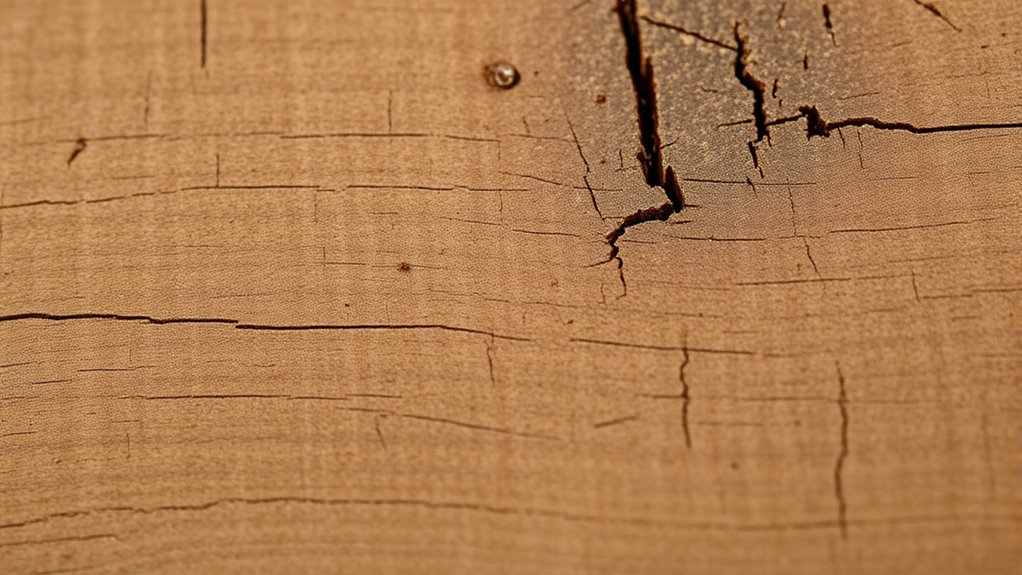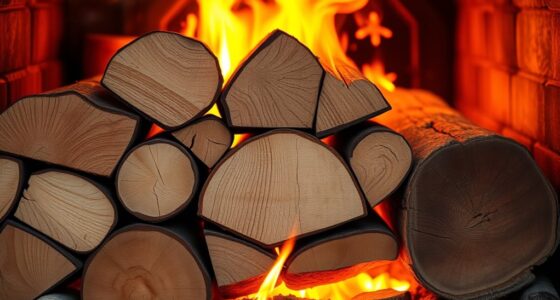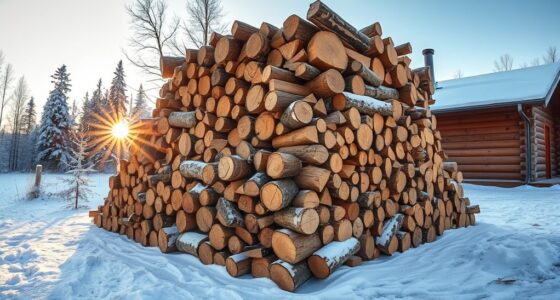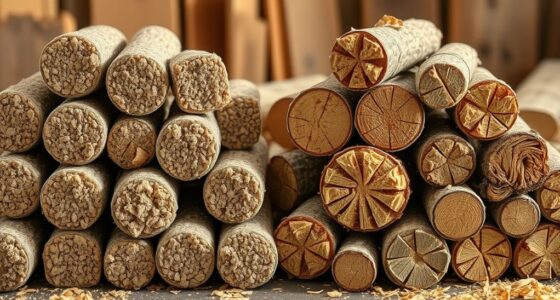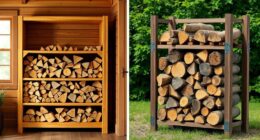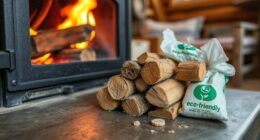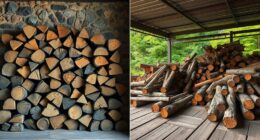To identify and avoid treated or contaminated wood, look for stamps indicating chemical treatment, a greenish tint, or a strong chemical smell. Avoid wood with paint, stains, or suspicious residues, especially for projects involving soil, food, or children. Use gloves and masks during handling, and always dispose of suspicious wood properly to prevent environmental harm. Learning more can help you confidently recognize hazards and protect your health and environment.
Key Takeaways
- Look for chemical treatment stamps, distinctive odors, or greenish tint indicating pressure-treated wood.
- Watch for signs of paint, stains, or chemical residues that may suggest contamination.
- Avoid using wood without proper labels or markings confirming it is untreated and safe.
- Conduct testing or consult experts to identify hazardous substances before using suspect wood.
- Handle with protective gear and dispose of contaminated wood following environmental safety guidelines.
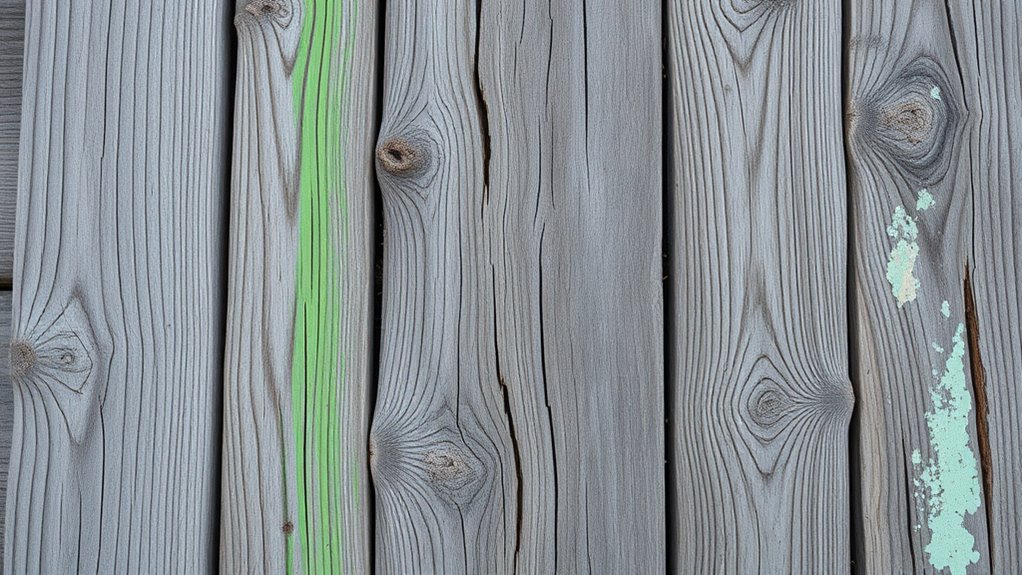
When working with wood, it’s important to know whether it’s treated or contaminated, as this impacts how you should handle, use, and dispose of it. Treated wood has been processed with chemicals to enhance durability, resistance to pests, or weathering, but these chemicals can pose health and environmental risks. Contaminated wood, on the other hand, may have been exposed to hazardous substances like paints, solvents, or pollutants, which can be harmful if mishandled. Recognizing the difference is essential to avoid health hazards and minimize environmental impact.
One of the key concerns with treated wood is chemical leaching. Over time, chemicals such as copper-based preservatives or arsenic compounds can gradually leach out, especially when exposed to moisture or sunlight. This process, known as chemical leaching, can contaminate soil and water, posing risks to wildlife, plants, and humans. If you’re planning to use treated wood outdoors or in contact with soil, you should be aware of this potential leaching and its long-term environmental impact. For example, using treated wood for garden beds or play structures can introduce harmful chemicals into the environment, which may contaminate groundwater or be ingested by garden plants or children playing nearby.
Chemical leaching from treated wood can contaminate soil and water, risking wildlife, plants, and human health.
Identifying treated or contaminated wood begins with inspecting the wood for labels or markings. Treated lumber typically bears stamps indicating the type of chemical treatment and safety precautions. If markings are absent, consider the wood’s appearance and location—pressure-treated wood often has a greenish tint or a distinctive smell. Contaminated wood may show signs of paint, stains, or chemical residues. Avoid using any wood that looks suspect or if its origin is unclear. When in doubt, consult environmental or safety guidelines to determine whether the wood contains hazardous substances. Additionally, wood that is certified as untreated or natural is preferable for projects involving contact with soil or food, ensuring safety and reducing environmental risks. Recognizing the importance of proper testing procedures can help identify potentially hazardous wood before use. It is also advisable to consider proper storage methods to prevent further contamination during storage or transportation. Being aware of proper disposal methods is also crucial to prevent environmental contamination and protect public health. Handling these materials with gloves and masks reduces health risks during removal and transportation.
Frequently Asked Questions
How Can I Test Wood for Chemical Contamination Effectively?
To test wood for chemical contamination effectively, you should use spectroscopic analysis, which detects chemical compounds through light absorption. Additionally, chemical test kits are handy for quick, on-site testing—simply follow the instructions to identify contaminants. Combining these methods gives you accurate results, helping you determine if the wood is safe for use or needs further treatment. Always prioritize safety when handling potentially contaminated materials.
Are There Natural Alternatives to Treated Wood for Outdoor Projects?
You can explore natural alternatives and eco-friendly options like cedar, redwood, or naturally rot-resistant woods such as oak or locust for outdoor projects. These woods are sustainable choices that resist decay without chemical treatments. Additionally, consider using composite materials made from recycled plastics, which are durable and environmentally friendly. By choosing these natural alternatives, you reduce chemical exposure and support eco-conscious building practices.
What Are the Long-Term Health Risks of Exposure to Treated Wood?
Exposure to treated wood can pose long-term health risks due to chemical exposure, such as potential respiratory issues, skin irritation, or even more serious effects like cancer. You might not notice immediate symptoms, but repeated contact increases your risk. To protect yourself, limit direct contact, wear gloves, and ensure proper ventilation. Being aware of these health effects helps you make safer choices and reduce your overall chemical exposure.
Can Contaminated Wood Be Safely Reused or Recycled?
You can’t safely reuse or recycle contaminated wood without risking serious health hazards. Recycling regulations are strict for contaminated materials, and contamination detection is vital before repurposing wood. Ignoring these rules can release toxic chemicals into your environment, creating a danger zone for everyone. Always have contaminated wood inspected by professionals, follow proper disposal protocols, and never gamble with your health by trying to recycle or reuse questionable wood yourself.
How Do I Identify Signs of Chemical Treatment on Wood Surfaces?
You can identify signs of chemical treatment on wood surfaces by looking for surface discoloration, such as greenish or bluish hues, which indicate chemical residue. Also, check for a chemical smell or greasy feel on the surface. If you notice any unusual color changes or odors, it’s a sign that the wood might be treated. Always exercise caution and wear gloves when handling suspected treated wood to avoid chemical exposure.
Conclusion
If you ignore the signs of treated or contaminated wood, you might as well invite disaster into your home. The risks are so enormous, they could turn your safe space into a disaster zone overnight. Don’t gamble with your health or your family’s safety—spot the warning signs, avoid the danger, and keep your world safe from hidden threats lurking in plain sight. Stay vigilant, because one wrong choice could release chaos you’ll regret forever.

